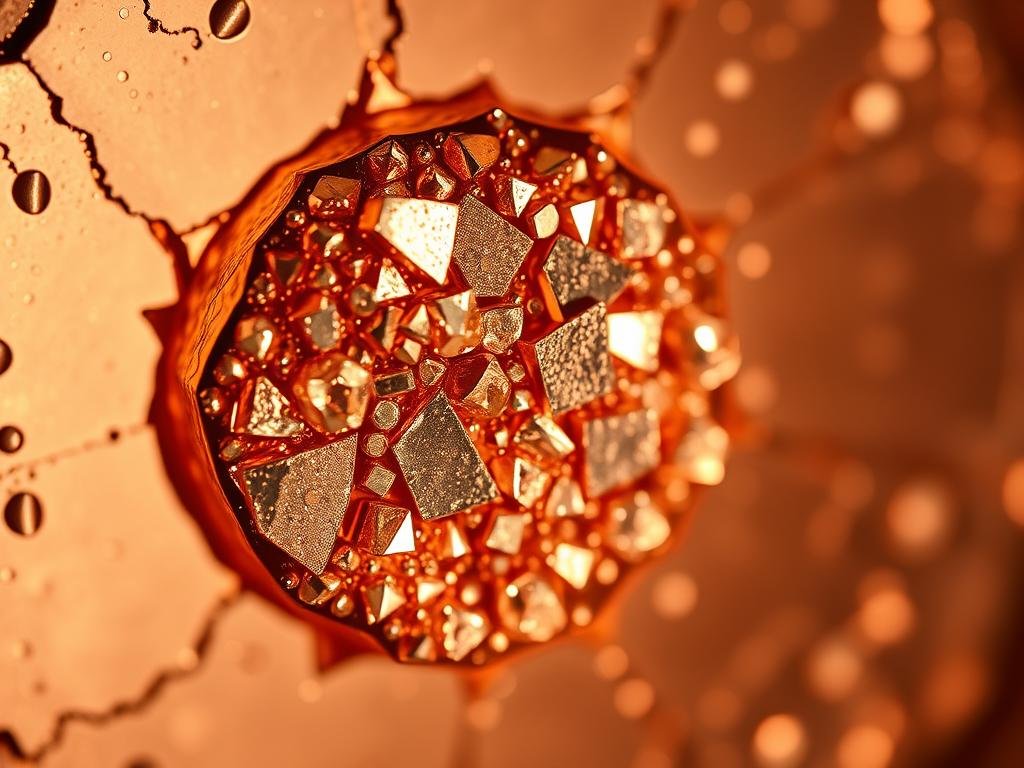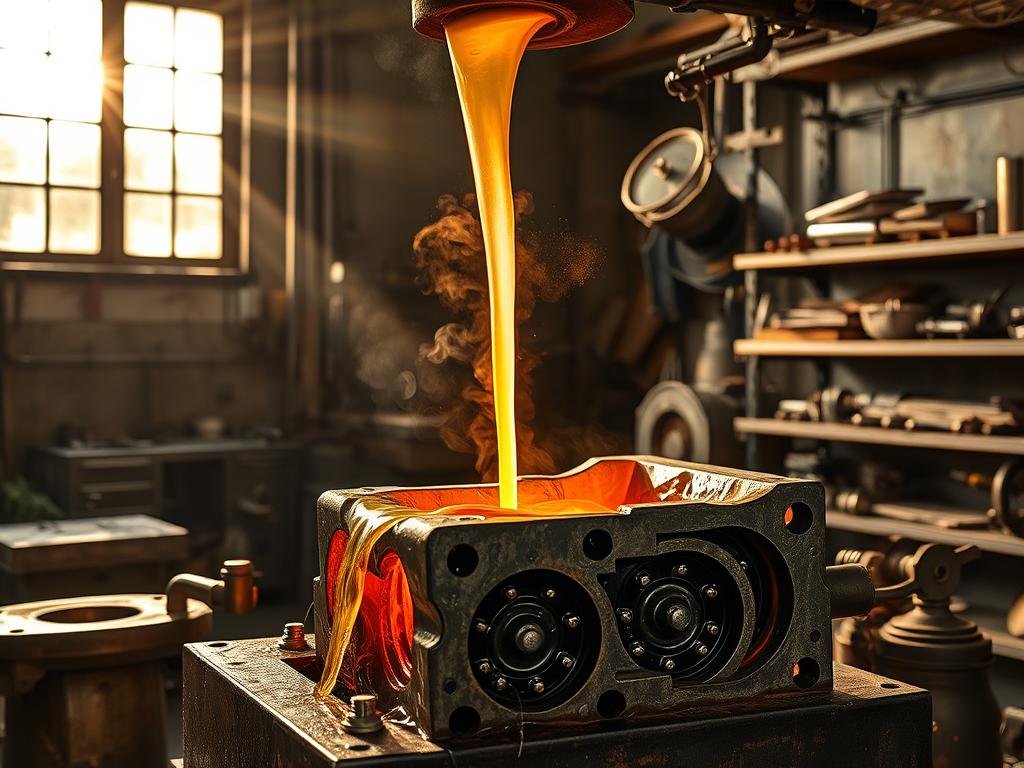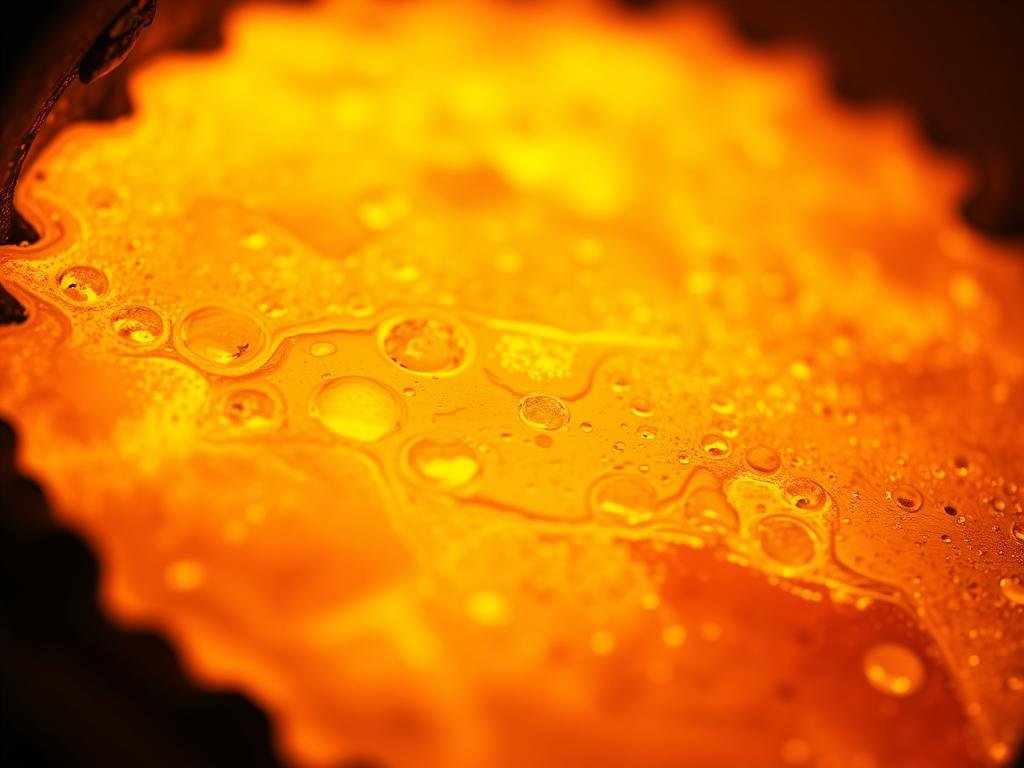Nearly one in ten alloys used in light‑metal casting sits in a melting range that spans over 100°C, and common brass grades often fall between 890°C and 1000°C.
We will outline the essential temperatures in both °C and °F, note typical quick references near 927°C (1700°F), and explain why that range matters for furnace selection and process reliability.
Expect practical advice on selecting grades, avoiding heat failures, and matching processes to tolerances. Rapidaccu’s 15+ years in CNC machining ensures this guide links melt data to manufacturable parts, from prototype to production.
The article will compare thermal behavior against copper, aluminum, and steels, and preview how monitoring, pouring, and cooling affect final quality and repeatability.
Understanding Brass and Melting Point Basics
When copper and zinc combine, the resulting alloy melts across a span of temperatures determined by composition and phases.
This copper‑zinc system typically contains about 55–95% copper and 5–45% zinc. Small additions such as lead, tin, aluminum, manganese, nickel, or silicon tune properties and processing behavior.
Alloy composition and elemental roles
Copper-rich mixes form an alpha phase that stays ductile and machines well. Higher zinc promotes beta phase, which raises hardness and shifts the melting interval.
- Alpha vs. beta phases affect workability and liquid formation.
- Minor elements alter fluidity, corrosion resistance, and machinability.
- Solidus and liquidus establish a working temperature window rather than a single number.
How phase ranges guide processing
Knowing the solidus (first melt) and liquidus (full liquid) helps set furnace targets and soak times. That avoids incomplete melting or excessive overheating.
Rapidaccu’s engineering team converts composition and thermal behavior into reliable parameters for precision parts, matching casting approach to finish and cost goals.
| Feature | Typical Range | Effect on Processing | Manufacturing Note |
|---|---|---|---|
| Copper content | 55–95% | Controls ductility and conductivity | Higher copper favors alpha phase, easier machining |
| Zinc content | 5–45% | Increases strength, shifts temperature range | Higher zinc yields more beta, tighter cast tolerance |
| Minor elements | ppm–few % | Modifies fluidity and corrosion | Additions tuned per part finish and cost |
| Solidus / Liquidus | Span across hundreds °C | Defines working window | Use melt control and soak to ensure full fluidity |
whats is the brass melting point: the essential range in °C and °F
Industrial brass grades show a melting interval that depends on composition and added elements.
Typical temperatures
Common alloys reach fluidity across roughly 900–1000°C, which equals about 1650–1770°F.
For setup and quick checks many operators use 1700°F (≈927°C) as a practical midpoint.
Why an interval, not a single value
Alloy phases create a solidus where softening begins and a liquidus where full flow occurs. This span defines a working window.
Copper‑rich mixes push the liquidus higher while zinc‑rich grades start to melt earlier. Additions like aluminum or manganese can also raise the upper band.
- Too low: risks incomplete melt and inclusions.
- Too high: increases oxidation and chemistry shifts.
- Accurate thermocouple placement and regular calibration are essential to hit the correct band.
Controlled temperature within this interval improves gating, mold preheat strategy, and casting fluidity. Rapidaccu sets practical melt targets inside that band to protect integrity and secure consistent surface finish for downstream CNC machining. For a concise reference, see this melting point reference: melting point reference.
How composition drives the brass melting point
Changing copper and zinc proportion shifts solidus and liquidus values across a wide band. Higher copper content pushes the full‑liquid temperature upward, while more zinc lowers the onset of flow.
Typical content ranges run about 55–95% copper and 5–45% zinc, and those proportions tune melting behavior and machinability. Rapidaccu helps customers select mixes that balance thermal needs with finish and tool life.
Effect of copper vs. zinc proportion on melting points
Copper‑rich alloys tend to show higher solidus/liquidus temperatures. Zinc‑rich mixes begin softening nearer to 900°C and reach fluidity earlier.
Role of alloying elements
Lead improves chip control and can slightly reduce effective melt onset via eutectic effects. Tin boosts corrosion resistance and nudges the temperature window.

| Element | Effect on temperature | Manufacturing note |
|---|---|---|
| Lead | Lower onset | Better machinability |
| Aluminum / Manganese | Raise liquidus | Tighter furnace control |
| Nickel / Silicon | Modify liquid range | Change finish and strength |
- Alloying alters fluidity and gating design.
- Precise composition reduces porosity and ensures repeatable properties.
- Choose grades with Rapidaccu to match melt behavior to machining and surface goals. See a concise melting reference: melting points of metals.
Melting temperatures by common brass grades
Common commercial grades show distinct temperature windows that guide casting and furnace setup.
Alpha and beta ranges
Alpha alloys typically run about 900–965°C. These stay more ductile and flow predictably.
Beta structures push liquidus higher, roughly 990–1060°C. That added heat alters gating and mold prep.
Representative grade windows
- C260 (cartridge): ~900–940°C, a balanced copper zinc mix for general parts.
- C360 (free‑cutting): lower effective onset (~875–900°C) thanks to lead, aiding post‑cast machining.
- C230 (red): ~950–1080°C, copper‑rich and higher in temperature, better corrosion resistance.
- C464 (naval): ~890–920°C, tin/aluminum additions give corrosion control and a practical melt band.
- C220 (commercial bronze): ~1032–1060°C, sits at the upper end due to higher copper.
Practical grade notes
Yellow grades often fall near 900–1010°C and suit general casting. Red grades need higher setpoints.
Architectural mixes that cast fine detail tend to melt lower, around 870–900°C, but demand oxidation control.
| Grade | Typical window (°C) | Manufacturing note |
|---|---|---|
| C260 | 900–940 | Good balance for machining and finishing |
| C360 | 875–900 | Lead improves chip control; easier machining after casting |
| C464 | 890–920 | Naval grade; corrosion resistance, consistent fluidity |
| C220 | 1032–1060 | Copper‑rich; higher furnace setpoints needed |
Choosing the right grade reduces cold shuts, limits oxidation, and sets correct mold preheat and gating. Rapidaccu can advise which point brass suits casting and CNC needs to hit dimensional targets and finish goals.
Factors that can raise or lower the melting point during processing
Manufacturing conditions such as heating rate, atmosphere, and pressure change the effective window where an alloy softens and flows. Controlling these factors reduces variability and improves part quality.
Grain size, microstructure, and heat treatment
Fine grains and a uniform phase mix can shift observed melt behavior and help material flow into molds. Annealing or cold work changes internal structure and alters solidus behavior.
Impurities, oxidation, and heating rate
Surface oxides and trace contaminants act as insulators and raise energy needed to reach full fluidity. Fast heat‑up can cause hot spots or leave large charges partly unmelted. Flux and controlled atmosphere limit oxidation and inclusions.
Pressure and casting technique considerations
Higher pressure typically raises the melt temperature slightly, an important factor for high‑pressure processes. Sand casting requires more superheat than die casting because heat extraction and apparent fluidity differ.
- Consistent thermocouple placement and dwell time stabilize temperature before pouring.
- Charge homogeneity and flux choice reduce inclusions and improve surface finish.
- Process control lowers porosity and gives predictable machining allowances.
| Variable | Effect | Manufacturing note |
|---|---|---|
| Grain size | Shifts observed melt behavior | Refinement improves flow |
| Oxidation | Raises energy demand | Use atmosphere control or flux |
| Pressure | Elevates melt temperature | Relevant for high‑pressure casting |
Rapidaccu’s controlled processes manage heating rates and atmospheres to protect chemistry, surface condition, and final quality. That routine keeps outcomes stable despite variable components and small impurities.
From solid to liquid: how brass melting and casting are performed
A reliable pour begins long before metal flows—material prep, furnace choice, and fluxing set the stage. This section walks through practical shop steps to convert charge into finished components that meet dimensional and surface requirements.
Material preparation, furnace charging, and fluxing
Clean, sort, and size the charge to promote uniform chemistry and steady heat uptake. Remove contaminants and segregate returns to avoid composition shifts.
Select a furnace type—induction for tight control or gas-fired for larger batches—and size it so capacity exceeds the expected melting temperature. Add borax‑type flux to limit oxide formation and improve fluidity during heat up.

Monitoring melt temperature, skimming, and pouring
Use calibrated probes placed near the melt pool to record melting temperature and confirm proper superheat above liquidus. Log readings and maintain dwell time so chemistry stays stable.
Skim dross regularly to remove inclusions that harm surface integrity. Choose gravity pours for simple sections and pressure methods when fine detail or thin walls demand better fill.
Cooling, solidification, surface treatments, and quality control
Manage cooling rates and mold design to control shrinkage, avoid cold shuts, and reduce residual stress. Preheat molds and optimize gating for consistent fill.
After solidification, perform fettling, polishing, and any surface treatment needed before CNC finishing. In‑process checks—chemistry tests, temperature logs, visual inspection, and NDT where required—ensure part quality.
| Process step | Key control | Result |
|---|---|---|
| Charge prep | Chemistry & cleanliness | Predictable composition |
| Furnace & flux | Capacity & oxide control | Improved fluidity |
| Temp monitoring | Calibrated probes | Correct superheat |
| Post-cast | Fettling & inspection | Ready for machining |
- Prepare and size charge for uniform heating.
- Flux and heat to target melting temperature; skim dross.
- Select pouring method to match part geometry.
- Control cooling, then finish surfaces and verify quality.
Rapidaccu supports end‑to‑end manufacturability: advising on melt targets, documenting process control, and delivering precise CNC parts with repeatable surface finish from prototype to production. For a concise melting reference, see melting point guide.
How brass compares: melting points of copper, aluminum, steel, and more
A short alloy comparison makes clear which shop gear, fluxes, and molds suit each material. Rapidaccu leverages cross‑material experience to recommend processes whether you select brass, copper, aluminum, or steels for your application.
Quick reference: common metals and typical temperatures
| Metal | Typical melting point (°F) | Typical melting point (°C) | Practical note |
|---|---|---|---|
| Brass | ~1700°F | ≈927°C | Mid‑range, balanced for valves and fittings |
| Copper | 1981°F | 1083°C | High temp; great electrical conductivity |
| Aluminum | 1218°F | 659°C | Low temp, lightweight components |
| Steel / Stainless | ~2500–2750°F | 1371–1510°C | Requires robust refractories and higher energy |
What these differences mean for casting and applications
Brass sits mid‑range: lower than copper and steels, higher than aluminum and zinc. That affects furnace capacity and energy use.
Lower‑temp metals need less superheat but can oxidize quickly and demand different flux or atmosphere control. High‑temp alloys need stronger refractories and longer soak times.
- Thermal conductivity: copper and aluminum pull heat fast, impacting mold chill and riser design.
- Fluidity and oxidation govern gating, riser sizing, and pour speed across alloys.
- Application fit: brass for fittings, aluminum for light parts, copper for electrical, steels for structure.
Understanding comparative melting points helps plan multi‑alloy production and choose dedicated vs universal equipment. Rapidaccu advises on material tradeoffs, balancing superheat, cycle time, and finish to meet machining and application goals.
Designing and machining brass parts with melting temperature in mind
A controlled melt history directly affects chip formation, surface finish, and final tolerances during CNC work.
Why a moderate melting range supports CNC machining
Brass’s moderate thermal behavior gives steady thermal tolerance during cutting. That helps preserve dimensions when tools generate heat.
Grades with good machinability, like C360, form predictable chips and reduce tool wear. This means fewer stoppages and higher quality parts.
Choosing the right alloy for casting, machining, and surface quality
Pick alloys to match corrosion, strength, and finish demands. C260 and C230 suit deeper forming with post‑machining, while C360 aids smooth finishes.
- Naval alloys for corrosion resistance and service life.
- Architectural mixes for consistent color and polish.
- Red or yellow variants based on strength and appearance needs.
How Rapidaccu ensures precision, finish, and consistency from prototype to production
Rapidaccu leverages 15+ years of CNC machining to align casting choices with tooling, coolant strategy, and feeds/speeds.
Our process controls include toolpath optimization, in‑process inspection, surface metrology, and precision gauging to protect critical features.
| Focus | Shop action | Result |
|---|---|---|
| Thermal management | Tooling choice, coolant, conservative feeds | Stable surface finish and minimized distortion |
| Alloy selection | DFM feedback on grade and casting route | Matched machinability and part strength |
| Production control | In‑process checks and metrology | Repeatable quality from prototype to run |
Early collaboration lets Rapidaccu balance alloy, pour strategy, and CNC plan to hit cost and quality targets for varied applications.
Conclusion
A practical understanding of thermal intervals helps you set repeatable process targets.
Brass typically runs across a working range near 900–1000°C (1650–1770°F). This span, shaped by copper‑zinc balance and alloying, means there is no single solid melt value. Control of heating rate, oxidation, and pressure keeps temperatures steady and reduces defects.
Use alloy choice to tune machinability and final surface finish. Translate melting data into actions: set melt targets, manage pour and cool, then plan CNC feeds and coolant for consistent quality.
Rapidaccu stands ready to help select grade, validate process, and deliver precision CNC parts from prototype to production.

